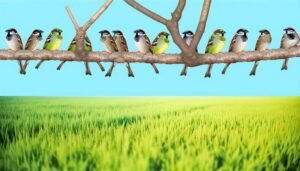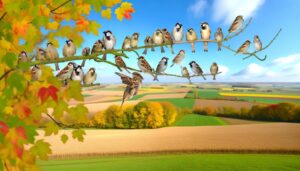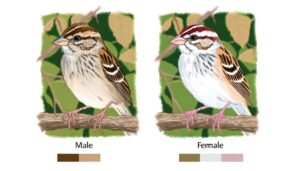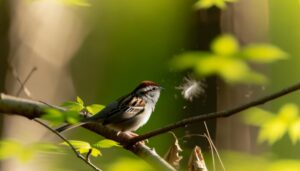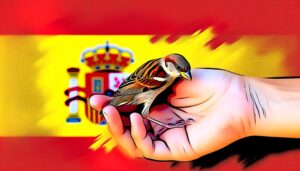Identifying Florida Grasshopper Sparrows: Key Facts
The Florida Grasshopper Sparrow is a critically endangered bird native to Florida's arid prairies. Measuring approximately 5 inches in length and weighing 17 grams, it's recognizable by its unique 'buzzing' song and brown-grey plumage that blends with its surroundings.
Mainly feeding on insects, it also consumes seeds during the winter months. Its 'run-and-pause' hunting method and the ability to extract water from food demonstrate its adaptability to the challenging environment.
The sparrow lays 3-4 eggs per clutch, often producing two broods per season. Numerous conservation efforts are underway to guarantee the species' survival.
There's much more to discover about this remarkable bird.
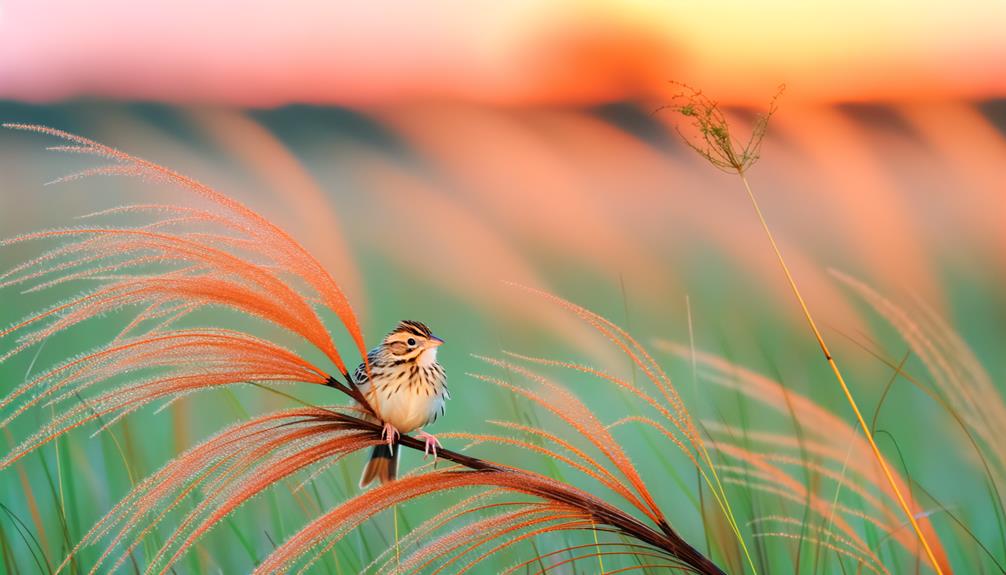
Key Takeaways
- The Florida Grasshopper Sparrow, Ammodramus savannarum floridanus, is an endemic bird species found only in Florida's prairies.
- This petite bird, averaging 5 inches in length, has a distinct 'buzzing' song resembling that of grasshoppers.
- The sparrow primarily feeds on insects like grasshoppers and beetles, supplementing with seeds and grains in winter.
- Nesting occurs in dense grasslands, with females laying 3-4 eggs per clutch and often having two broods per season.
- Conservation efforts, including habitat management and captive breeding programs, aim to protect this species from population decline.
Understanding the Grasshopper Sparrow's Identity
In the world of ornithology, the Florida Grasshopper Sparrow holds a unique identity, boasting a distinct song reminiscent of grasshoppers, a petite size, and a brown-grey plumage that allows it to blend seamlessly with its prairie grass habitat.
This sparrow, scientifically named Ammodramus savannarum floridanus, is an endemic species, found nowhere else in the world but Florida. Its 'buzzing' song sets it apart from other sparrows, a characteristic believed to be an adaptation to its specific environment.
The sparrow's small stature, averaging at 5 inches in length and 17 grams in weight, further distinguishes it. Its feather pattern, a mix of brown, grey, and white, is an evolutionary trait providing excellent camouflage against predators.
The Sparrow's Unique Habitat
Nestled within the heart of Florida's dry prairie ecosystem, the Florida Grasshopper Sparrow has carved out a habitat uniquely suited to its needs. The bird's habitat choice demonstrates its adaptability and resilience in the face of harsh living conditions.
| Habitat Feature | Sparrow's Use | Importance |
|---|---|---|
| Sparse Vegetation | Provides cover | Enables hiding from predators |
| Low Grasses | Nesting site | Allows for ground-level nesting |
| Sandy Soils | Food foraging | Facilitates detection of insects |
The sparrow's habitat preference reflects its ecological role as a ground-dwelling species. It's a master of survival, thriving in this challenging environment. The Florida Grasshopper Sparrow's unique habitat is a tribute to its strength, resilience, and adaptability, which are critical to its survival in Florida's dry prairie ecosystem.
Diet and Feeding Habits
Beyond its choice of habitat, the Florida Grasshopper Sparrow's diet and feeding habits further underscore its remarkable adaptability. It's primarily insectivorous, consuming a wide range of insects such as grasshoppers, beetles, and spiders.
However, it's been observed to supplement its diet with seeds and grains, particularly in winter months when insects are scarce. The sparrow employs a 'run-and-pause' hunting technique, darting swiftly to catch prey, then pausing to scan for more.
It's also been noted to forage in mixed-species groups, a behavior that enhances food-finding efficiency. Notably, it doesn't drink water directly but obtains it from its food, an adaptation that enables survival in its dry, prairie habitat.
Reproduction and Nesting Patterns
The Florida Grasshopper Sparrow engages in a fascinating, complex breeding cycle, typically starting its nesting season in April and extending through August. The sparrow's nesting behavior includes a variety of unique aspects that contribute to the perpetuation of the species and the survival of its offspring.
- Females primarily construct the nests, using grasses to form a cup-like structure hidden in the dense grassland vegetation.
- Each female typically lays 3-4 eggs per clutch, with an incubation period of up to two weeks.
- Male sparrows contribute to the rearing of the young by feeding the fledglings after they leave the nest.
- They often have two broods per season, but if a nest fails, they'll attempt to re-nest.
This in-depth look into the sparrow's reproduction and nesting patterns provides a greater understanding of their life cycle and survival strategies.
Conservation Efforts for the Species
In response to the significant decline in their population, concerted conservation efforts are underway to protect the Florida Grasshopper Sparrow and its habitat.
Organizations, such as the U.S. Fish and Wildlife Service, are working hard to monitor and manage the remaining populations. They're establishing controlled burns to maintain the sparrows' preferred habitat of dry prairie. These burns prevent overgrowth and allow for the growth of plants that the sparrows rely on for nesting and food.
Additionally, captive breeding programs are in place to increase the sparrow's numbers. Eggs are collected from the wild, hatched and raised in captivity, then released when they're mature. This strategy aims to augment the wild population and increase the species' chance of survival.
Conclusion
Ironically, the diminutive Florida Grasshopper Sparrow, unassuming in its presence, holds the weight of an entire ecosystem on its tiny shoulders. Its decline, a stark reminder of our own environmental mishaps, has prompted a surge in conservation efforts.
As we work to safeguard its unique habitat, reestablish its diet, and protect its nesting patterns, we aren't just preserving a species. We are, essentially, preserving ourselves, the caretakers of this intricate, interconnected web of life.


